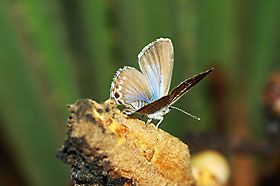THE CULPRIT It’s this cycad blue butterfly which is doing the damage.
sick cycads
Don Burke says if your sago palm is looking sick, the most likely culprit is a butterfly and its caterpillar. The good news is that there are safe sprays which can control the problem.
We have been inundated with emails (see right) from people experiencing problems with their sago palms – that is the cycad called Cycas revoluta. The classic symptoms are areas of new growth in the centres of the foliage, where the leaves go yellow and the edges turn a whitish-straw colour. This is caused by a butterfly which lays its eggs on the flush of new growth each year and its caterpillars do the damage. The butterfly is called the cycad blue butterfly (Theclinesthes onycha).
Fortunately its caterpillars can be controlled with Dipel, pyrethrum or Yates Success. All of these are natural products derived from diseases of cater-pillars – that is, they aren’t poisonous to people, birds and animals in general.
The critical thing to remember is to spray the plant as the new growth begins to unfold, and repeat the sprays after rain, as the sprays will wash off. Spray-ing plants a week or two before the leaves open would be absolutely ideal, so keep a close eye on your sago palms. The photo, left, shows the cycad blue butterfly. The caterpillars are a deep burgundy colour as they mature.
problems aplenty!
Burke’s Backyard magazine has received a stack of letters and emails from readers experiencing the same problems with their cycads. Here’s a selection of reports:

1. Lyn Menadue managed to kill the caterpillars with a caterpillar spray, but one of her cycads now has this nasty yellowing on all its leaves.

2. Nerida Hart, of Brisbane, is worried that her four 12-year-old cycads might not survive. Pictured here, it looks crook, and while these leaves won’t recover the new leaves should be OK if she takes Don’s advice.

3. Graeme Coulter wrote in to say: “My mum tells me that this plant is a Cycad revoluta. However she doesn’t know what is causing the deterioration of the plant and I am hoping you can help.”

4. Bruce Southgate, of Kellyville in NSW, sent in some good photos of the problem, one of which is pictured here.
George Grone, on the NSW Central Coast, gave us a detailed description of the problem with his 18-year-old cycad. Understandably, he doesn’t want to lose it!
The good news is the solution is simple. Use Dipel, Success or pyrethrum and any of these will control the caterpillars responsible. Spray as new growth unfolds, repeat the sprays after rain, and keep going until the leaves have fully opened out.


